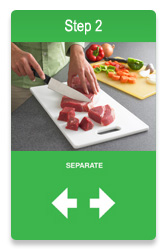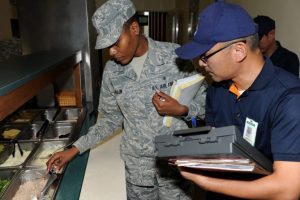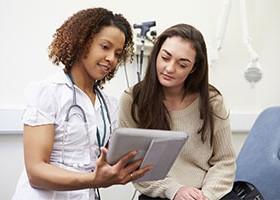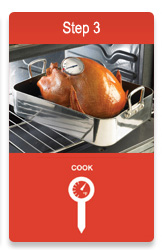
Step 1 – Clean
Clean hands are a must! Food is only as safe as the hands that prepare it.
If hands are dirty, all of the food they touch becomes contaminated with pathogens (disease causing germs).
Wash hands thoroughly with warm soapy water for at least 20 seconds and use a disposable towel to dry them.
 Step 2 – Separate
Step 2 – Separate
It is very important to keep kitchen surfaces like cutting boards, counter tops and food utensils clean and sanitary.
Wash these surfaces with warm soapy water, rinse them and let them air dry before beginning to work with food.
Never place clean food items on dirty surfaces because food will become contaminated (dirty) and could make you sick.
Step 3 – Cook
ALWAYS monitor your cooking temperatures with a calibrated or digital metal-stem thermometer to make sure that your food is cooked to the right temperature.
ALWAYS stick the probe into the thickest or deepest part of the food to be sure food is cooked all the way to the center. Hold it there for 15 seconds to be sure it reaches the right temperature.
Under-cooked food can make you sick and possibly kill you.
For a list of proper cooking temperatures, please click here.
 Step 4 – Chill
Step 4 – Chill
Keep hot foods hot and cold foods cold!
Never store foods between 42-134⁰F because this range is known as the DANGER ZONE!
Food stored in the temperature danger zone quickly grows pathogens (disease-causing germs)
Pathogens in food can make a person very sick in a matter of hours.
ALWAYS monitor your refrigerator temperature by purchasing a small, plastic thermometer that easily fits on any shelf.
Check it once or twice weekly to be sure it stays between 38-41⁰F .
Risks to maintaining food safety
The Centers for Disease Control and Prevention has identified five risk factors that are the cause of foodborne illness in homes and restaurants.
The Five CDC Risk Factors
- Getting food from an approved source or vendor
- Maintaining proper cooking temperatures
- Properly cooling food
- Maintaining clean and sanitary equipment
- Good personal hygiene
Tips for preparing healthy and safe food
- Wash produce thoroughly to remove dirt which could contain pathogens (disease-causing germs).
- Keep raw and ready to eat foods separate to prevent cross contamination – raw foods can contain pathogens that can make you sick.
- Store raw food below and separate from ready to eat foods.
- Before and after using cutting boards, knives and other utensils, wash them thoroughly with warm soapy water.
Clean hands are a must
- Wash your hands, wash your hands and wash your hands!
- Limit bare hand contact with foods that do not need cooking (cookies, chips, bread etc.)
- Use napkins, spatulas, tongs, wax paper, etc. to limit contacting your food with your bare hands
How to tell if food is completely cooked
- Use a probe thermometer to test temperature
- Cook all chicken and all poultry items, stuffed meat or stuffed fish, and exotic meats to 165° F
- Cook ground beef, ground pork and raw egg dishes to 155° F
- Cook fish and seafood to 145°F
- Cook produce and all other foods to 135°F
What to do to be sure that the food served is safe
- Keep cooked food held hot at 135°F or higher
- Keep your refrigerator at 41°F or below
- Don’t leave food outside of refrigeration for more than 4 hours
- Remember to keep hot food hot and cold food cold
How to store food in the refrigerator
- Keep your raw food at the bottom of your refrigerator and separate it from ready-to-eat foods
- Install a hanging thermometer and regularly check the temperature..
How long to keep foods and still consider them safe
Visit the USDA Food and Safety website to learn more
Visit the FoodSafety.gov website
What to do with leftovers and how to reheat them
- Refrigerate all doggy bags and leftovers right away
- Don’t put hot food in the refrigerator. Cool rapidly first.
- Cool down foods in small portions so they cool faster
- Reheat all leftovers quickly
- Throw out leftovers after five days in the refrigerator
How to properly thaw food
- In the refrigerator
- Under cold running water in the sink
- As part of the cooking process
- In the microwave for immediate cooking
The difference between “use by, sell by, and best when purchased by”
Additional Resources
- Avoid these Dangerous Food Safety Mistakes
- Food Keeper App
- How to Clean Your Produce Using Vinegar
- Kitchen Companion Booklet
- Local food inspection reports can be found here
Emergency Preparedness Links
- Keeping Food Safe During an Emergency – Frequently Asked Questions – USDA
- Making Water Safe During an Emergency – CDC
- When to keep or discard food products




